Nonenzymatic turnover of an Erwinia carotovora quorum-sensing signaling molecule
- PMID: 11807077
- PMCID: PMC134803
- DOI: 10.1128/jb.184.4.1163-1171.2002
Nonenzymatic turnover of an Erwinia carotovora quorum-sensing signaling molecule
Abstract
The production of virulence factors and carbapenem antibiotic in the phytopathogen Erwinia carotovora is under the control of quorum sensing. The quorum-sensing signaling molecule, N-(3-oxohexanoyl)-L-homoserine lactone (OHHL), accumulates in log-phase culture supernatants of E. carotovora but diminishes in concentration during the stationary phase. In this study, we show that the diminution in OHHL was not due to sequestration of the ligand by the cells, although some partitioning did occur. Rather, it was caused by degradation of the molecule. The rate of stationary-phase degradation of OHHL was as rapid as the rate of log-phase accumulation of the ligand, but it was nonenzymatic and led to a decrease in the expression of selected genes known to be under the control of quorum sensing. The degradation of OHHL was dependent on the pH of the supernatant, which increased as the growth curve progressed in cultures grown in Luria-Bertani medium from pH 7 to approximately 8.5. OHHL became unstable over a narrow pH range (pH 7 to 8). Instability was increased at high temperatures even at neutral pH but could be prevented at the growth temperature (30 degrees C) by buffering the samples at pH 6.8. These results may provide a rationale for the observation that an early response of plants which are under attack by Erwinia is to activate a proton pump which alkalizes the site of infection to a pH of >8.2.
Figures
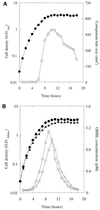
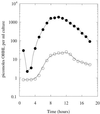

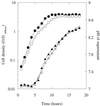
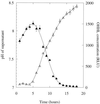

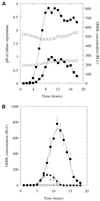
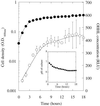
References
-
- Bainton, N. J., B. W. Bycroft, S.-R. Chhabra, P. Stead, I. Gledhill, P. J. Hill, C. E. D. Rees, M. K. Winson, G. P. C. Salmond, G. S. A. B. Stewart, and P. Williams. 1992. A general role for the lux autoinducer in bacterial cell signaling: control of antibiotic synthesis in Erwinia. Gene 116:87-92. - PubMed
-
- Baker, C. J., M. M. Atkinson, M. A. Roy, and A. Collmer. 1986. Inhibition of the hypersensitive response in tobacco by pectate lyases. Physiol. Mol. Plant Pathol. 29:217-225.
-
- Baker, C. J., N. Mock, M. M. Atkinson, and S. W. Hutcheson. 1990. Inhibition of the hypersensitive response in tobacco by pectate lyase digests of cell wall and of polygalacturonic acid. Physiol. Mol. Plant Pathol. 37:133-167.
Publication types
MeSH terms
Substances
LinkOut - more resources
Full Text Sources
Other Literature Sources

